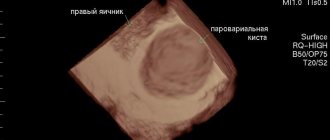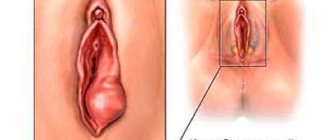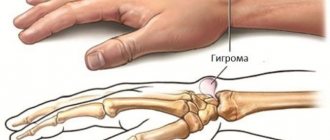Cyst is the name of a new formation in the upper part of the tooth root, which occurs due to infection entering the dental canal and the development of an inflammatory process. Treatment of the cyst should begin when the primary symptoms of its appearance appear, otherwise serious complications are possible that can lead to the need for tooth extraction.
We will talk in detail about what a dental cyst is and what causes its appearance in the root canal in the following sections of the article. Let us also consider the symptoms of the disease and methods of its treatment.
What is a dental cyst?
As briefly mentioned above, a dental cyst is a cavity formation that is tightly attached to the upper part of the tooth root and is located directly in the bone tissue. The inside of the cyst cavity is not empty: pus accumulates in it. Another name for the pathology in question is periodontal abscess. If you do not start treating a cyst at the first symptoms of its appearance, the formation will gradually grow, and this is fraught with various negative complications for human health.
Particularly rapid growth rates are observed in cysts that arise in the upper jaw area. What are the causes of a dental cyst?
Factors that provoke the occurrence of a dental cyst
The only reason why a dental cyst forms is the penetration of pathogenic microorganisms into the root canals, observed under the following circumstances:
1. Lack of timely treatment of caries and pulpitis. Tissues corroded by carious lesions are a favorable environment for the proliferation of various pathogens. If a person does not go to the dentist for treatment of caries, then the disease destroys the tooth down to the pulp, bacteria enter it and cause the onset of the inflammatory process. Pulp inflammation in dentistry has its own terminological designation – pulpitis.
If the patient ignores the occurrence of pulpitis, then the infection will penetrate even deeper - into the root canals of the tooth and reach the upper part of the tooth roots. At this stage of the inflammatory process, a cyst forms.
2. Poor quality of root canal filling in the treatment of pulpitis or periodontitis. High-quality dental canal filling involves careful processing and placement of a special composite material into the canal to the very top of the roots. If this is not done, then an inflammatory process may begin in the root canal and its result will be the formation of a cyst.
As statistics show, it is the poor quality of tooth root canal treatment that most often provokes the appearance of a cyst at the root apex. That is why it is so important to treat any dental diseases in professional, well-equipped clinics and competent specialists. In our dentistry in Moscow - “Vanstom”, dental treatment services are provided at the European level of quality!
Causes
There are several reasons why a dental cyst develops. The main reason is the activity of pathogenic microorganisms in a closed dental space; the following risk factors contribute to this:
- severe pathology, lack of timely treatment and incorrect treatment of dental diseases - caries, periodontitis, pulpitis;
- infectious complications after tooth filling, implantation procedures - in such cases, the doctor removes not only the cyst, but also the crown or implant, this avoids relapse;
- complications during teething, especially when wisdom teeth erupt - dental tissues injure the gums, bacteria get into microcracks,
- microorganisms also enter wounds that form due to mechanical damage to teeth;
- Nasopharyngeal diseases – infections in the nose and throat can spread to the oral cavity.
To provide adequate treatment, it is necessary to accurately determine the cause of the development of a dental cyst; based on it, the dentist will prescribe suitable therapy. So, in cases of injury, treatment consists of removing the cyst and tissue regeneration, but if the cyst is a complication of another disease, then in addition to removing the vesicle, the patient will be prescribed treatment for the underlying disease.
Symptoms of a cyst on a tooth
A characteristic feature of dental cysts as a disease is primary asymptomaticity. For a long time, the cyst may not reveal its appearance in any way, and then the tumor can be detected only in one way - radiography. Timely detection of a cyst gives a chance to preserve the dental unit, and that is why it is so important to undergo regular preventive examinations at the dentist.
However, most often minimal symptoms of the cyst are present. Signs of the appearance of a dental cyst include: pain of moderate intensity when biting on a tooth in the root of which a purulent cavity has appeared, painful sensations in the gum area at the location of the tumor. If you notice similar symptoms, don’t wait to visit the Vanstom dental specialist’s office! Our clinic is located in the center of Moscow, a five-minute walk from the Baumanskaya metro station. To make an appointment, call the clinic’s contact number or use the call back service!
The cyst manifests itself most clearly in the acute phase of development, which is usually observed when the patient’s immune system malfunctions (influenza, acute respiratory viral infections, acute respiratory infections). In the acute phase, the symptoms of the cyst will be expressed in severe, almost unbearable pain, swelling of the mucous membrane, and increased body temperature.
Secondary symptoms
After a certain time, a formed tooth root cyst provokes symptoms:
- reaction to temperatures - contact with cold and hot food and drinks;
- pain - especially intensifies when chewing hard foods or eating sweets;
- feeling of pressure, a foreign body under the root of the tooth.
They may appear and disappear again. The severity of the symptoms is usually insignificant, so a visit to the doctor, even if the symptoms are constantly present, is often postponed. However, until the disease reaches the acute stage - when the symptoms increase significantly.
Treatment options for dental cysts
To effectively treat a dental cyst, one of two methods can be chosen - therapeutic (conservative) or surgical. Cyst therapy does not involve surgical intervention, and is considered the most gentle way to treat pathology. The choice of a specific technique is determined based on the individual characteristics of a particular case. Let's find out when the most appropriate choice in favor of a therapeutic treatment method will be.
Conservative treatment of a dental cyst is indicated in the following circumstances:
- Root canals have not been filled before, and there is no need to unfill them;
- The size of a dental cyst does not exceed one centimeter in diameter.
But the surgical method of treating cysts has its own indications, among which it is worth highlighting:
- Low quality of root canal filling along their entire length;
- A pin structure installed in the dental canal;
- The presence of a crown on a diseased tooth;
- The diameter of the tooth cyst exceeds 1 cm;
- Regular swelling of the gums, periodic pain.
Important note: Surgical treatment in the presence of a pin or crown is carried out subject to high-quality filling of the root canals to approximately two-thirds of their length. Only the upper part of the root may be unfilled.
A detailed overview of the main stages of conservative treatment of a dental cyst
Conservative treatment of a dental cyst will be long-term: on average, the treatment process lasts for 3-4 months. The patient will have to visit the dentist regularly. The course of treatment is divided into several stages, which we will describe in detail below.
Clinical researches
Repeated clinical studies have proven that the two-component mouth rinse ASEPTA ACTIVE more effectively combats the causes of inflammation and bleeding compared to single-component rinses - it reduces inflammation by 41% and reduces bleeding gums by 43%.
Sources:
- The role of anti-inflammatory rinse in the treatment of periodontal diseases (L.Yu. Orekhova, A.A. Leontyev, S.B. Ulitovsky) L.Yu. OREKHOVA, Doctor of Medical Sciences, Prof., Head of Department; A.A. LEONTIEV, dentist; S.B. ULITOVSKY, Doctor of Medical Sciences, Prof. Department of Therapeutic Dentistry of St. Petersburg State Medical University named after. acad. I. P. Pavlova
- Report on the determination/confirmation of the preventive properties of personal oral hygiene products “ASEPTA PLUS” Remineralization doctor-researcher A.A. Leontyev, head Department of Preventive Dentistry, Doctor of Medical Sciences, Professor S.B. Ulitovsky First St. Petersburg State Medical University named after. acad. I.P. Pavlova, Department of Preventive Dentistry
- Clinical studies of antisensitive toothpaste “Asepta Sensitive” (A.A. Leontyev, O.V. Kalinina, S.B. Ulitovsky) A.A. LEONTIEV, dentist O.V. KALININA, dentist S.B. ULITOVSKY, Doctor of Medical Sciences, Prof. Department of Therapeutic Dentistry, St. Petersburg State Medical University named after. acad. I.P. Pavlova
Root canal treatment
If the root canals of the patient’s diseased tooth have not previously been filled, then the first step in treating the cyst will be removal of the pulp and thorough treatment of the canal cavities. If the canals were filled, they will need to be unsealed. Next, the canals must be sanitized, since the cyst contains purulent fluid. Sanitation of the canals is carried out by repeatedly washing them with special antiseptic solutions.
Introduction of antiseptic and temporary filling of canals
In order to stop the inflammatory process and eliminate the infection, a potent antiseptic is injected into the upper part of the root, or more precisely, directly into the cavity of the cyst. These manipulations are carried out with a special tool. After the drug is administered, the specialist performs a temporary filling of the canals with antiseptic paste.
A full course of treatment for a dental cyst will require regular replacement of the antiseptic and filling paste; to carry out these procedures, the patient should regularly visit the treating dentist.
Monitoring the success of therapy
During the treatment process, activities are regularly carried out that allow the effectiveness of dental cyst therapy to be assessed. In particular, an x-ray is taken in the area of the diseased tooth. If the photograph taken shows the fact that the cyst has decreased in diameter, it means that its treatment has a positive result.
It is also important that during the course of treatment the patient does not complain of pain or other discomfort or general weakness.
Permanent filling of canals and installation of a crown on a tooth
If stable positive results of treatment of the dental cyst are maintained, the root canals are permanently filled with gutta-percha composite material, after which the natural crown part of the tooth is restored using the filling. When talking about the therapeutic treatment of dental cysts, it is important to note that this method does not have a 100% guarantee of effectiveness. Carrying out therapeutic manipulations may not help stop the growth of the cyst and then the formation will need to be removed surgically.
The surgical method does not always involve removing the cyst and tooth; in some cases, it is possible to remove the formation with part of the root and preserve the dental unit. Such an intervention is carried out in a hospital setting, and after that the patient is prescribed a course of antiseptics and antibiotics. IMPORTANT! The choice of treatment method for a dental cyst is always chosen by the dentist after examining the patient and obtaining X-ray results.
Consequences
Without adequate treatment, the dental cyst continues to grow and develop; in advanced stages, large neoplasms destroy the bone tissue of the skull, as a result it is replaced by connective tissue formations, which leads to the development of the following complications:
- dissolution of the jaw bone, which depends on the growth of the cyst;
- the formation of pus in the cyst, further purulent inflammation can lead to the development of an abscess;
- inflammatory process of lymph nodes located near the source of infection;
- development of osteomyelitis or periostitis;
- development of chronic sinusitis when the cyst grows in the maxillary sinus;
- pathological fracture of the jaw bones when the cyst reaches a large size;
- development of phlegmon due to a long-term purulent inflammatory process in the cyst;
- sepsis – blood poisoning;
- degeneration of a cyst into a malignant tumor without timely treatment.
Many patients are interested in why a dental cyst appears in the maxillary sinus, how dangerous it is and its symptoms. The formation of a cyst of this type occurs as a result of untreated inflammation of the tooth root in the upper jaw. A granuloma forms at the root of the tooth, which increases in size and becomes a peri-radicular cyst, then takes a position in the maxillary sinus. The volume of such a cyst can reach 9-12 cubic centimeters.
The symptomatic picture includes painful sensations, the nature of which is similar to trigeminal neuralgia, pain in the occipital, temporal and parietal regions of the head. Externally, a dental cyst can be identified by the asymmetry of the face. Tooth cyst - photo shows a cyst in the maxillary sinus.
Are folk remedies effective in treating dental cysts?
Because of the fear of pain when visiting the dentist's office, some people try to cure a cyst on their own and look for recipes for this of all kinds of folk remedies, learning them from friends or reading them on the Internet. Doing this is not only useless, but also unsafe. It is important to understand that the formation of a cyst is always provoked by infection of the root canals of the tooth, and in some cases, the most modern and potent professional pharmaceuticals are useless against the infection. In addition, high-quality treatment of dental cysts always involves removing the affected tissue and thoroughly flushing the canals. Without these manipulations, the cyst will not disappear anywhere - on the contrary, it will only grow.
If the cyst grows significantly, it is impossible to remove it and save the tooth. In addition, as the inflammatory process progresses, other negative health consequences may occur. Therefore, even with the initial symptoms of the appearance of a formation, you should not hesitate. Call and make an appointment with the specialists of our dental clinic in Moscow - Vanstom! We are located in the center of Moscow, next to the Baumanskaya metro station.
Types of cysts
- Retention cysts are formed due to obstruction of outflow. An example is small cysts on the oral mucosa that appear when the salivary gland duct is blocked.
- Ramolitic cysts are formed as a result of softening of tissue during its partial necrosis (sometimes due to inflammation, pressure, trauma, hemorrhage, heart attacks). In the maxillofacial area, these are most often cysts associated with infection or tooth overload due to malocclusion, less often - traumatic cysts.
- Parasitic - around a parasite that has settled in the tissues.
- Tumor - when cavities form in the structure of the tumor.
- Dysontogenetic – associated with disturbances in the formation of organs and tissues (when areas of epithelial tissue remain where they should not be and a cyst appears due to secretion and accumulation of secretion).
The last three species are extremely rare in the maxillofacial region.











